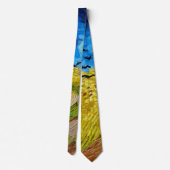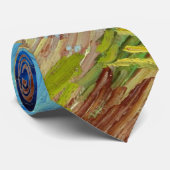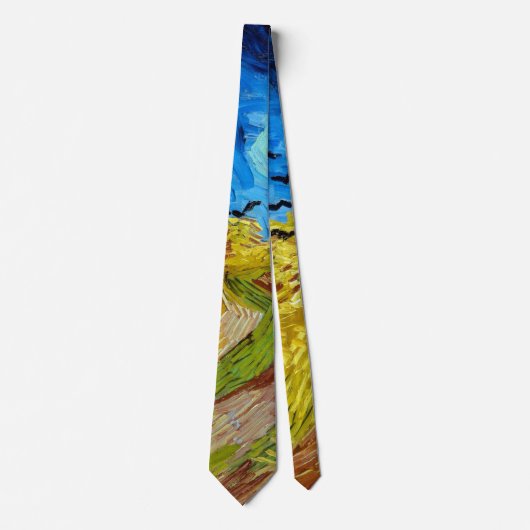A propos de Cravates
Vendu (e) par
À propos de ce design
Cravate Wheatfield with Crows, Van Gogh
Vincent Willem van Gogh (30 March 1853 – 29 July 1890) was a Dutch post-impressionist painter who is among the most famous and influential figures in the history of Western art. In just over a decade, he created about 2,100 artworks, including around 860 oil paintings, most of which date from the last two years of his life. They include landscapes, still lifes, portraits and self-portraits, and are characterised by bold colours and dramatic, impulsive and expressive brushwork that contributed to the foundations of modern art. He was not commercially successful, and his suicide at 37 came after years of mental illness, depression and poverty.
Born into an upper-middle-class family, Van Gogh drew as a child and was serious, quiet, and thoughtful. As a young man he worked as an art dealer, often travelling, but became depressed after he was transferred to London. He turned to religion and spent time as a Protestant missionary in southern Belgium. He drifted in ill health and solitude before taking up painting in 1881, having moved back home with his parents. His younger brother Theo supported him financially, and the two kept up a long correspondence by letter. His early works, mostly still lifes and depictions of peasant labourers, contain few signs of the vivid colour that distinguished his later work. In 1886, he moved to Paris, where he met members of the avant-garde, including Émile Bernard and Paul Gauguin, who were reacting against the Impressionist sensibility. As his work developed he created a new approach to still lifes and local landscapes. His paintings grew brighter in colour as he developed a style that became fully realised during his stay in Arles in the south of France in 1888. During this period he broadened his subject matter to include series of olive trees, wheat fields and sunflowers.
Van Gogh suffered from psychotic episodes and delusions and though he worried about his mental stability, he often neglected his physical health, did not eat properly and drank heavily. His friendship with Gauguin ended after a confrontation with a razor when, in a rage, he severed part of his own left ear. He spent time in psychiatric hospitals, including a period at Saint-Rémy. After he discharged himself and moved to the Auberge Ravoux in Auvers-sur-Oise near Paris, he came under the care of the homeopathic doctor Paul Gachet. His depression continued and on 27 July 1890, Van Gogh shot himself in the chest with a Lefaucheux revolver. He died from his injuries two days later.
Van Gogh was unsuccessful during his lifetime, and was considered a madman and a failure. He became famous after his suicide, and exists in the public imagination as the quintessential misunderstood genius, the artist ""where discourses on madness and creativity converge"". His reputation began to grow in the early 20th century as elements of his painting style came to be incorporated by the Fauves and German Expressionists. He attained widespread critical, commercial and popular success over the ensuing decades, and is remembered as an important but tragic painter, whose troubled personality typifies the romantic ideal of the tortured artist. Today, Van Gogh's works are among the world's most expensive paintings to have ever sold, and his legacy is honoured by a museum in his name, the Van Gogh Museum in Amsterdam, which holds the world's largest collection of his paintings and drawings. Quote:Wikipedia
Avis des clients
3.6 sur 5 étoiles5 Nombres de Commentaires
5 Commentaires
Avis sur des produits similaires
4 sur 5 étoiles
Par Christian D.18 avril 2023 • Achat sécurisé
Cravate
Programme d'évaluation de Zazzle
Ce produit a été bien réalisé avec de belles couleurs et de beaux logos. Aucun souci avec ces deux cravates
5 sur 5 étoiles
Par Christian D.24 février 2023 • Achat sécurisé
Cravate
Programme d'évaluation de Zazzle
Un beau logo bien imprimé et avec un chouette rendu. aucun souci malgré les détails
4 sur 5 étoiles
Par Christian D.9 décembre 2023 • Achat sécurisé
Cravate
Programme d'évaluation de Zazzle
facile à concevoir, joli choix de caractère, de couleur et facile de mettre ce que l'on veut. Les couleurs pourraient être un peu plus fortes sinon, joli rendu
Tags
Autres infos
Identifiant du produit : 151169810973951992
Fabriqué le 02/08/2020 18:39
Évalué G
Articles vus récemment




